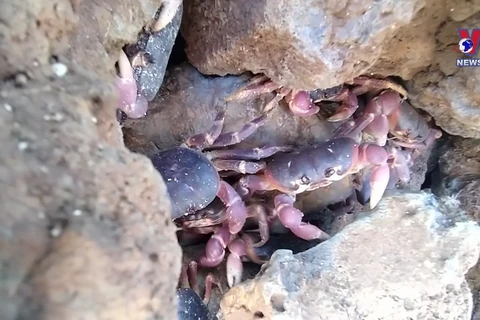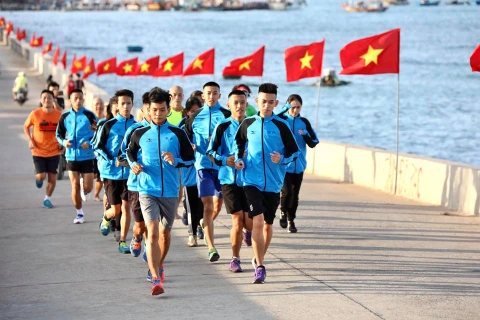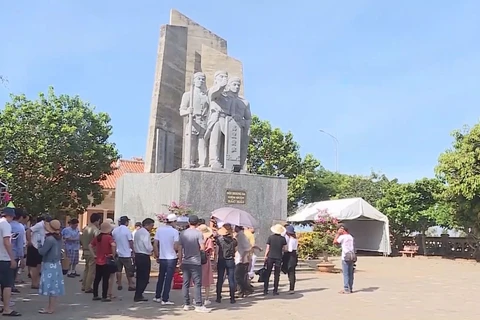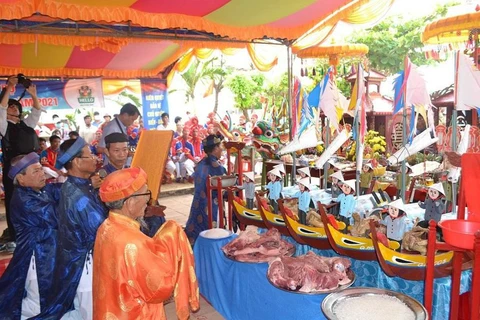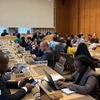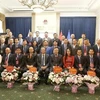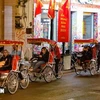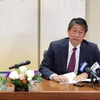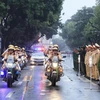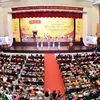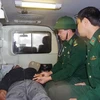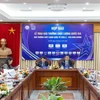 An bird's eye view of Ly Son Islands, off the coast of Quang Ngai Province. (Photo courtesy of Bui Thanh Trung)
An bird's eye view of Ly Son Islands, off the coast of Quang Ngai Province. (Photo courtesy of Bui Thanh Trung) The future development of the islands was discussed at a recent online talk among more than 100 Vietnamese archaeologists, geologists, volcano researchers, historians, conservationists and experts in education, tourism and planning.
The participants agreed that overloaded infrastructure projects in the future will destroy the geological structure and ecosystem on the islands.
Researchers raised concerns as local authorities recently proposed development plans including an international airport and expanding the island area.
“Ly Son Islands, which were naturally formed over millions of years, are an outpost of the country’s defence and security in the East Sea. They have cemented the country’s sovereignty on the sea and islands including Truong Sa (Spratly) and Hoang Sa (Paracel) archipelagos,” said Vo Van Minh from Da Nang University of Education.
“The sea expansion will surely damage coral reefs, seagrass beds and biodiversity in waters off the islands. It will erode the islands’ foundation and risk collapse,” he explained.
The islands still hold the Hoang Sa festival, recognised as an intangible cultural heritage, that has been observed for hundreds of years by local fishing families.
The festival pays tribute to local men who enlisted in the Hoang Sa Flotilla. This group was organised to patrol the Hoang Sa and Truong Sa archipelagos in order to mine resources and defend the nation's sovereignty over the territorial waters.
Centuries-old houses are still preserved, as is Am Linh Pagoda, built to worship the souls of sailors who died during long, regular patrols of Hoang Sa and Truong Sa islands in the Nguyen Dynasty (in the 17th century).
A local museum displays over 200 ancient documents and 100 exhibits that prove that Hoang Sa and Truong Sa islands belong to Vietnam.
Former director of the Vietnam Institute of Geosciences and Mineral Resources, Tran Tan Van, said the recognition of the Ly Son-Sa Huynh Global Geo-Park will help Quang Ngai preserve its heritage and contribute to economic growth.
He said the dossier for the recognition had passed the initial assessment by experts from the International Union of Geological Sciences (IUGS) on the international geological heritage value, and it needs a field survey for revaluation of the islands’ heritage.
Ly Son Islands were formed by five mountains, of which four are dormant volcanoes.
Nguyen Van Long, from the Institute of Oceanography, under the Vietnam Academy for Science and Technology, said Ly Son Islands have one of the largest areas of coral reef on 1,706ha, and 116ha of seagrass bed in Vietnam.
He said the seas off the islands has huge seafood resources with more than 1,200 tonnes being caught, bringing an income of 212 billion VND (9.2 million USD) per year.
Long said field assessments reported that human activities in recent years had damaged the ecological system off the islands.
“Over-fishing, or fishing by explosives, plastic waste pollution and climate change have bleached coral reefs and sea anemone in the area,” Long said.
He said the islands, which have high biodiversity with 768 species, need to be urgently protected and conserved.
Senior lecturer of the HCM City-based Marketing and Finance University, Dang Van My, said Ly Son Islands had not yet taken advantage of its tourism potential.
Tourists could visit the islands in the six months of the dry season (between April and October), while boat trips to the islands in the off-season were limited, he added.
“Investors could not get back their investments in resorts and hotels from six months of tourism service annually. So, property speculation follows the tourism investors,” he warned.
Bui Thi Thu Hien, marine and coastal resource programme co-ordinator from the International Union for Conservation of Nature (IUCN), said a ‘blue sea’ economy should be planned for Ly Son Islands, but this would require a huge fund for conservation activities.
She said the World Economic Forum 2020 reported that for every dollar spent on nature restoration, at least 9 USD of economic benefits can be expected.
The IUNC launched a communication campaign to promote the non-use of plastic bags as a prelude to its sea turtle conservation programme on Ly Son from 2017-2018.
Hien said it would be impossible for Ly Son to host 4 million tourists when the islands’ underground water reserve can barely supply enough for islanders during the dry season.
She said the islands could not boost their ‘blue sea’ economy without further research on biodiversity and ecology.
Dr Chu Manh Trinh, a nature conservationist from the Cham Islands Marine Protected Area, suggested Ly Son promote its prosperity from nature conservation.
“Ly Son Islands could be a large ‘school’ and an ‘outdoor museum’ for researchers and students in exploring the geological heritage from ancient volcanoes and archaeology as well as fishing communities,” he said.
Pham Van Cong, founder and CEO of Dori company, said the islands’ economy, which is based on agriculture, fishing and tourism, had not benefited islanders, only tourism investors and service suppliers from the mainland.
“Tourism properties occupy a third of the total area on the islands, while half of the islands’ population make their living from growing garlic and purple onion,” Cong said.
“Most young men leave the islands after high school, causing a serious lack of human resources. Only low-educated adults remain and source an income from fishing and farming.”
Vo Minh Tuan, a member of the Ly Son-Sa Huynh Global Geo-Park management board, said underground water sources had been polluted by the over-use of 2,000 wells on the islands.
“Poor quality water would lead to rising health problems in the community. Waste treatment and afforestation plans have not yet been developed,” Tuan said.
An expert who wished to remain anonymous said building an international airport on the islands was unfeasible.
“The island, just 1.3km in length, is too short to the standard 3.5km runaway for hosting Airbus aircrafts. At least 288ha, or a third of the island will be reserved for infrastructure of the airport. It means that farming land, the port and a vast water area will be cleared for the airport,” he said.
The islands are accessible by a 30-minute speed-boat trip, while Chu Lai airport in Quang Nam is 30km away, and Da Nang International airport is a 90-minute bus ride.
Speaking at a press conference in April, Chairman of the Quang Ngai provincial People’s Committee Dang Van Minh said the dossier for UNESCO recognition of the Ly Son-Sa Huynh Global Geo-Park had been halted.
He said the park, which covers 4,600sq.km including 2,000sq.km of sea, will not reserve lands for economic plans.
However, General Decretary of the Global Geoparks Network and Chairperson of the UNESCO Global Geoparks Council, Guy Martini, said the Quang Ngai People’s Committee said the park could not limit industrial zones or urban zones if these projects are legal and follow Vietnamese environmental legislation.
The islands host around 200,000 tourists annually, with 18 hotels and 56 homestay facilities built to accommodate 1,000 tourists.
A ‘Non-carbon Island Initiative’ project including reverse osmosis (RO) desalination plants, wave-to-energy technology and battery-powered vehicles was planned for the islands, but was postponed due to COVID-19 pandemic./.
VNA
